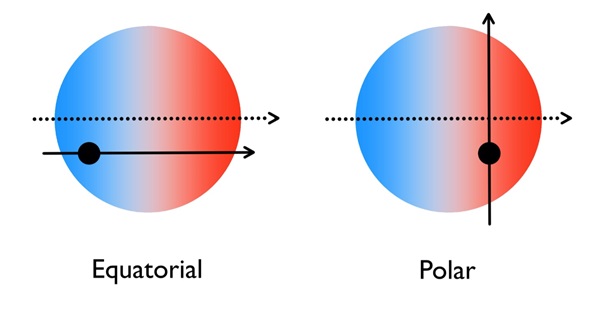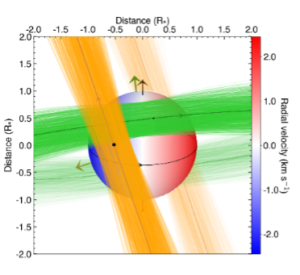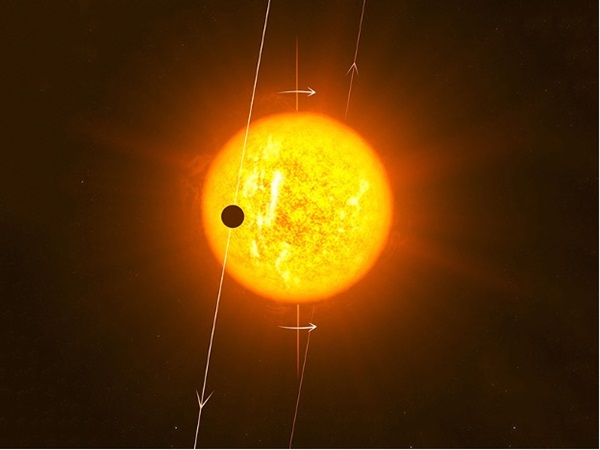Exoplanets with topsy-turvy orbits found around inconspicuous star
Astronomers have discovered a system in which the planets’ orbits are nearly perpendicular to each other.
The planets of our solar system all orbit the Sun within a few degrees of a flat plane extending out from our star’s equator — its equatorial plane. That makes sense. Our solar system began as a shapeless, spinning cloud of gas and dust. Eventually, with a budding, rotating star forming at its core, the conservation of angular momentum caused this spinning cloud to flatten out into a disk. That rotating disk of material gave birth to all the planets of our solar system. So, overlooking the finer intricacies, it seems difficult to imagine the major planets orbiting our host star in any other way.
Surprisingly, however, the more we gaze toward other stars, the more we realize that our solar system is not the norm. For example, take the three planets orbiting HD 3167, an inconspicuous star some 150 light-years away in the constellation Pisces. According to a new study published Oct. 27 in Astronomy & Astrophysics, some of this system’s planets circle their host star in orbits almost perpendicular to the star’s equatorial plane. Although the scientists are still trying to understand how this wacky configuration arose, they suspect that the gravitational tug of a fourth, as-yet-undiscovered massive planet is to blame.
Following a planet’s shadow
All three known planets in this strange system could easily fit within the orbit of Mercury. The innermost planet is HD 3167b, a super-Earth about five times as massive and 1.7 times as wide as Earth. Rapidly moving in a tight orbit, HD 3167b circles its star in less than a day. The outermost planet, HD 3167c, takes about 30 days to orbit its host. HD 3176c is a mini-Neptune with a mass of about 10 Earths. Orbiting between these two worlds, with a period of about 8.5 days, is another mini-Neptune: HD 3167d.
Both the inner planet (b) and the outer planet (c) transit their host star from our perspective, providing astronomers the data they need to calculate accurate sizes and masses. What’s more, these transits also allow researchers to determine the orientation of each planet’s orbit.

“A star is not a point source, it is a big object, and it rotates by itself,” explains Vincent Bourrier, a research and teaching fellow at the University of Geneva and lead author of the new study. The light coming from the side of the star that is moving towards us appears bluer, and the light coming from the side moving away from us appears redder. A planet gives away its orbital motion when it passes in front of the star’s surface, occulting (or blocking) parts of the star that move at different velocities.
In recent years, Bourrier and his colleagues in Geneva have improved their ability to tease out planetary orbits using this principle. And the extra effort paid off in 2019, when they found that HD 3176c orbits its host star’s pole, not in its equatorial plane. The middle planet (d) likely has a similarly inclined, highly misaligned polar orbit.
Now, the new paper has pushed this technique to its limits to determine the orbital motion of the innermost planet (b), which is to date the smallest planet to be studied in this way. The result was surprising: HD 3167b’s orbit is nearly perpendicular to that of HD 3167c.

Surprising planetary architectures
This is not the first time astronomers have measured the orientation of the orbits of several planets around the same star. For example, the orbits of two planets in the Kepler-56 system are both tilted by about 45° compared to their star’s equatorial plane. Likewise, the primary in the triple-star system K2-290A harbors two planets whose orbits are tilted by 124° compared to their star — and those planets actually move in the opposite direction of their star’s rotation.
Still, the HD 3167 system is so far unique. “I haven’t seen such a large mutual inclination actually measured in a system of two close-in planets before,” says Rebekah Dawson, an associate professor at Pennsylvania State University who was not involved in the new study.
What could cause planets in the same system to have such profoundly different orbits? The team suggests that another, more massive planet might be lurking in the outskirts of the system. If so, its gravity could have caused the misaligned orbits of the inner planets. On the other hand, the innermost planet has been so strongly coupled to the star that it has retained its initial alignment.
Dawson agrees that the proposed scenario is viable. However, she says, at this point the available information is not sufficient to make firm conclusions. It would help to know the HD 3167c’s eccentricity, which is a measure of how elliptical an orbit is. “In most [planet perturbation] cases, I would expect a high eccentricity,” says Dawson.
Bourrier and his colleagues are already busy further scrutinizing the system. Additional observations of the star’s light should further pin down the planets’ orbits, including their eccentricities, which are not yet known. Furthermore, the team will search for direct evidence of the putative fourth planet. “With direct imaging you can, if you are lucky, directly detect light coming from an object,” says Bourrier.
Regardless of the outcome, the more planetary systems we study, the more it is clear that our solar system had a very different — and perhaps much smoother — history than many others. But a continuing stream of unexpected discoveries, such as the HD 3167 system, will help astronomers take stock of all possible planetary formation scenarios, perhaps shedding more light on what makes our Sun and the planets around it so special along the way.
Do not forget to share your opinion with us to provide you with the best posts !




Fascinating to find something dazzling and eccentric in the universe.